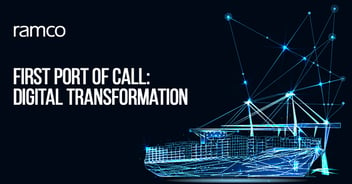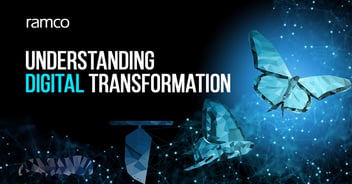

Seaports form an important and integral role in logistics and supply chains across the world. For they guarantee efficient and safe movement of goods around the globe. When all the other players in the industry are well on their way to using the latest digital technologies, it is imperative for the ports also to transform themselves digitally.
But first, let’s briefly look at the problems that ports are facing. The ports today are facing pressure in the form of constant demand to increase their efficiencies while reducing costs. The ship sizes have increased, the competition has increased, the shipping lines have become digitalised and the government is pressurising the ports to increase throughput with the same infrastructure and more control.
These reasons are why a port should decide to digitalise its operations. Let me give you an easy guide that will help you check the level of digitalisation your port has reached. Some of these points have been mentioned in the informative report/study titled, “IT-Enabled Business Transformation: From Automation to Business Scope Redefinition” by N.Venkatraman:
- Localised exploitation – This is when only a few processes in the port have been computerised, while others largely continue to be paper-based or manual efforts.
- Internally integrated – This is when all departments and functions have been computerised and the systems are talking to each other. This happens typically when there is a common ERP in place.
- Business process redesign – Happens where the processes have been optimised utilising the latest digital technologies. The process redesign resulting in elimination and automation is attempted here.
- Business network redesign – This is when data is exchanged between organisations interacting with the port. Collaboration is the key here.
- Business scope redesign – This is when previous ways of doing businesses are redesigned to include new services, new business models, and partnerships which are now enabled by the above four steps.
In 2017’s research paper titled, “An Analysis of Digital Transformation in the History and Future of Modern Ports” the authors differentiated between three main generations in the development of digital transformation in seaports. At Ramco, we have evolved the process of standardisation, optimisation and innovation. First is when we redesign the process to eliminate paper processes and standardise them across various group ports and departments. Second is when these are taken over by the computer wherever possible, and also suggest alternate actions. Third is when we evolve from old to new business models.

A major problem in any Digital Transformation initiative is that the tools available for digital transformation are far too advanced for companies to figure out how to use and to help them resolve their specific problems. An experienced partner who will be able to guide the port in isolating the exact problem, prioritising the value of that problem being solved, and actually creating a technology solution – has become a must.
While all the crucial functions need to be digitalised, important areas among them need to be picked and prioritised. One is the collaboration between all players, from the ships and the logistics agencies to quickly arrive at dynamic schedules, so that the ships are kept at the berth for the least time possible. The second is to maintain a very detailed view of the inventory for quick retrieval of the containers. The third is implementing an enterprise asset management strategy, through which the health of the asset is predicted by the systems that are constantly monitoring it with the help of sensors. Mobile-based and voice-based data input greatly enhances on-site inspections, data inputs.
Ports should look out for a solution partner for a payroll system that has all the necessary capabilities to help them in this transformation journey.
- Ensure that the payroll software has the technology toolset, including AI/ML engines, Chatbots, voice-based and visual-based systems, mobile alerts, etc. The platform must also provide a wide range of full-fledged ERP functions like finance, inventory, logistics, procurement, maintenance, project management, and HR. This will cover all the three generations of digital transformation we earlier discussed - removing the paper from the processes, eliminating data entry processes wherever feasible, collaborating with the network, and also predicting events like crane failures.
- In addition to the toolset, the partner must have a methodology to move the port from the current stage to the fifth stage. This should follow the three stages of standardisation, optimisation and innovation.
- Thirdly, verify if the chosen solution partner has the people and the right resources to effect this change. The ports should also show seriousness by driving this initiative right from the CEO level and giving this adequate time and budget.
Frequently Asked Questions (FAQs)
Enterprise asset management (EAM) involves the management of mission critical assets of an organization throughout each asset's lifecycle. EAM is used to plan, optimize, execute, and track the needed maintenance activities with the associated priorities, skills, materials, tools, and information. The aim is to optimize the quality and utilization of assets throughout their lifecycle, increase productive uptime and reduce operational costs.
Enterprise asset management (EAM) involves the management of the maintenance of physical assets of an organization throughout each asset's lifecycle. EAM is used to plan, optimize, execute, and track the needed maintenance activities with the associated priorities, skills, materials, tools, and information.
The software helps in effective maintenance of assets through preventive, predictive, shutdown and breakdown maintenance strategies. The system also helps enterprises mitigate equipment risks by enhanced safety standards. The streamlined operations and improved asset performance helps organizations increase their investment effectiveness.
EAM is important because it helps organizations track, assess, manage and optimize asset quality and reliability. Asset intensive Organizations have hundreds, thousands, even millions of assets which needs to be maintained to maximize / optimize life of these assets to increase the return on investment.
The key features of effective EAM are:
- Work management.
- Maintenance Strategies (Preventive/ Predictive / Breakdown / Shutdown).
- Planning and scheduling.
- Supply chain management.
- Health and safety.
- Mobility.
- Analytics.
- Improved Asset Health at reduced cost through data driven maintenance Programs
- Complete visibilityon entire maintenance data across Equipment, across Models, across Branches to aid in analysis & decision making such as to Repair or Replace the Equipment
- Insightful analysis of Inspection Data to improve customer satisfaction
- Effective maintenance management enhanced by predictive maintenance and inbuilt analytics
- Increased reliability and safety, keeps complete track of all the inspections & calibration schedules
- Mobile Application enables users to execute work while “in the field” leading to minimized non-productive time and increased productivity and reduces duplication of work and human errors in recording information.
- Quick turnaround time through Actionable Notification & Alerts for every process in real time and accessible anytime and anywhere.
- Improved Regulatory Part of asset management involves the implementation of better O&M practices, which can significantly improve compliance.
Asset Intensive companies under the following Industries :
- Ports
- Cement and Mining
- Utilities
- Fleet Maintenance
- Equipment Rental
- Other Manufacturing
- Real Estate & Infrastructure
- Power Generation
Contact us for a meeting and schedule a demo
This differs on case to case basis, based on the type of installation and unique industry specific requirements. Contact us for a meeting and schedule a demo.
This differs on case to case basis, based on the type of installation and unique industry specific requirements. Contact us for a meeting and schedule a demo.
Stay Connected, follow us on LinkedIn / Twitter to know more about EAM Software latest trends.


